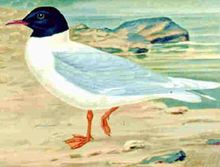Little gull: Difference between revisions
Luckas-bot (talk | contribs) m robot Adding: ca:Gavina menuda |
|||
| Line 38: | Line 38: | ||
[[Category:Larus]] |
[[Category:Larus]] |
||
[[Category:Birds of Asia]] |
[[Category:Birds of Asia]] |
||
[[Category:Birds of Iran]] |
|||
[[category:Birds of Pakistan]] |
[[category:Birds of Pakistan]] |
||
[[Category:Birds of Europe]] |
[[Category:Birds of Europe]] |
||
Revision as of 01:12, 25 August 2010
| Little Gull | |
|---|---|

| |
| First-summer immature | |
| Scientific classification | |
| Kingdom: | |
| Phylum: | |
| Class: | |
| Order: | |
| Family: | |
| Genus: | Hydrocoloeus Kaup, 1829
|
| Species: | H. minutus
|
| Binomial name | |
| Hydrocoloeus minutus | |
| Synonyms | |
|
Larus minutus | |
The Little Gull (Hydrocoloeus minutus) is a small gull which breeds in northern Europe and Asia. It also has small colonies in parts of northern Canada. It is migratory, wintering on coasts in western Europe, the Mediterranean and (in small numbers) the northeast USA. As is the case with many gulls, it has traditionally been placed in the genus Larus. It is the only member of the genus Hydrocoloeus, although it has been suggested that Ross's Gull also should be included in this genus.

This species breeds colonially on freshwater marshes, making a lined nest on the ground amongst vegetation. Normally, 2-6 eggs are laid.
This is the smallest gull species, with a length of 25-27 cm, a wingspan of 75-80 cm and a weight of 68-133 grammes. It is pale grey in breeding plumage with a black hood, dark underwings and often a pinkish flush on the breast. In winter, the head goes white apart from a darker cap and eye-spot. The bill is thin and black and the legs dark red. The flight on rounded wings is somewhat tern-like.
Young birds have black markings on the head and upperparts, and "W" pattern across the wings. They take three years to reach maturity.
These gulls pick food off the water surface, and will also catch insects in the air like a Black Tern.
References
- Template:IUCN2006 Database entry includes justification for why this species is of least concern
- Malling Olsen, Klaus and Hans Larsson, Gulls of Europe, Asia and North America ISBN 0-7136-7087-8
- BOU Records Committee, British Ornithologists' Union Records Committee: 36th Report (November 2007), Ibis (2008), 150, 218-220.
- Pons J.M., Hassanin, A., and Crochet P.A.(2005). Phylogenetic relationships within the Laridae (Charadriiformes: Aves) inferred from mitochondrial markers. Molecular phylogenetics and evolution 37(3):686-699

